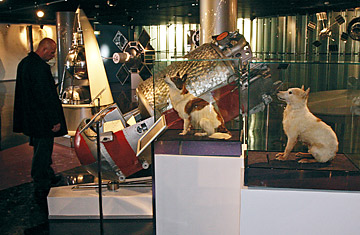
Inside the newly renovated Memorial Museum of Cosmonautics in Moscow
With a 360-ft.-high (110 m) steel flame swooping up from its roof, topped by a Jetsons-esque rocket, Moscow's Memorial Museum of Cosmonautics has opened again, after more than three years of expansion and renovation — one small step in Russia's effort to claim a more prominent place on the world stage by highlighting its past glory in space exploration.
"We wanted to build the new museum bigger and better, but the first goal was to remind young people of our glorious history, history that is being forgotten," says Alexander Laveikin, a deputy director of the museum and one of the first cosmonauts to have lived aboard the Mir space station. Besides serving as a memorial to the past, the museum, which reopened in March, is also part of a government effort to get young Russians interested in science and technology. "If five or 10 years ago, everyone wanted to be in business, now they are interested in technology — and our museum is playing a big part in that," says Laveikin. "After the financial crisis ends, they won't be interested in fast money anymore. Now we need to forget about business and oil and focus on rejuvenating our technology sector." (See pictures of the Hubble telescope.)
Indeed, as a new space race heats up — with China and India joining the U.S., Europe and Russia in the quest to be the first to build a moon base or put a man on Mars — Russia's government has done more than just revamp its space museum. In 2007, it founded Rosnanotekh, the Russian Nanotechnology Corporation; last year, the government announced tentative plans to abandon its current space base in Kazakhstan and build a new one in the Russian far east; and in March, it launched an effort to design a new moon rocket. (See pictures of animals in space.)
But two great hurdles stand in the way of Russia's realizing its space dreams: a collapsing public-education system and a brain drain that for decades has been siphoning off the country's highly trained engineers as they move to better-paying jobs in the West. It is this second issue that the museum aims to address. "We need our youth to become interested in space again," says Laveikin. "We need to develop a youthful corps of engineers and cosmonauts."
In order to draw in young people, the museum was renovated with an eye toward a more interactive experience, a concept unknown in Soviet-era museums, most of which have no pulse — and sometimes no lights. So there's a full-size mock-up of the Mir space station module and a theater that monitors the progress of the space station in real time via video link. Most of the museum, however, is made up of the usual look-but-don't-touch exhibits. A full-size model of the iconic Sputnik satellite is suspended from the ceiling, while the tiny capsule that Russian cosmonaut Yuri Gagarin used to orbit the Earth rests on a pedestal. In two glass cases at the entrance, the stuffed bodies of Belka and Strelka, the first dogs to return to Earth alive after a space flight, sit with their heads cocked inquisitively. Some of the halls are lined with kitschy "space art" (one piece shows a white-clad cosmonaut floating in a sea of dark swirls); other exhibits include examples of Soviet and Russian cosmonaut food, including black bread, borscht and caviar. The museum's efforts to appeal to kids appear to have worked — teenagers and children with their parents fill the small halls even on a weekday afternoon. (Read "The Cruise of the Vostok.")
But while young Russians seem to like what they see in the museum, translating a day of fun into a lifelong interest in science and technology remains a challenge. Some blame the school system. "My daughter is in second grade, and they're not taught anything," says Olga Fyodorova, visiting from St. Petersburg with her daughter Asya. "The biggest problem is that our children are not being taught history, math, chemistry and physics."
Others believe the problem lies in the upbringing of children born after the fall of the Soviet Union. "Students today are more interested in money and dancing," says Yuri Bogomolov, 79, a former scientist at a Soviet-era aerospace lab. "We have a lot of patriotism, but the U.S. has a lot of money [to put into its space program]," he adds as he watches a clip from White Sun of the Desert, a Soviet action-adventure film that cosmonauts traditionally — and superstitiously — watch before blasting off, ever since Gagarin watched it and returned alive from his first space flight. But Bogomolov has confidence that Russia can regain its standing as a space superpower. "[Prime Minister Vladimir] Putin is a strong leader. Now we know our path and we have a goal," he says, referring to the planned new moon rocket and cosmodrome. (See pictures of Putin.)
Wandering past model rockets, orange cosmonaut suits emblazoned with red U.S.S.R. emblems and a diorama of happy cosmonaut mannequins sitting around a campfire next to a crashed space capsule waiting for pickup, Lynn Nordstrom of Albuquerque, N.M., and her two sons — in Moscow for the Eurovision song contest — say they are enjoying their visit. But "after looking at this, I'm afraid of the Egypt syndrome, where all you do is talk about how great you used to be," Nordstrom says. "The museum is terrific, but you need to look to the future. My whole youth was spent hearing about the U.S.S.R. making advances in science and us always feeling like we were behind." (See the top 10 Eurovision controversies.)
Now, with a revamped museum, a new rocket program and possibly a new space base, it's Russia that's trying to catch up.
